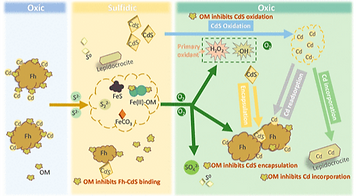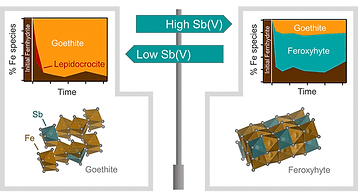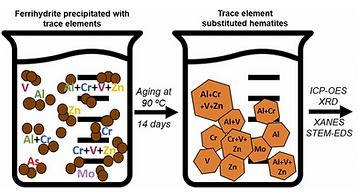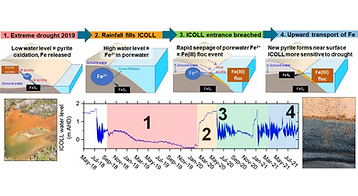

Research in the Environmental Geochemistry and Mineralogy group involves lab experiments and field studies, combined with advanced synchrotron-based X-ray techniques.
Our aim is unravel mineral formation/transformation processes and mineral-water interactions for better management of water quality, land contamination, pollutant mobility, soil productivity and hazardous waste.
We study a range of environmental systems including acid sulfate soils, acid mine drainage, contaminated land & water, freshwater & coastal wetlands, bushfire-impacted landscapes, legacy mine sites and associated mining-impacted locations.
Our research addresses the environmental geochemistry of many elements, including aluminium, antimony, arsenic, cadmium, carbon, chromium, iron, lead, manganese, mercury, phosphorus, REEs, sulfur, tungsten and vanadium.
Some of Our Recent & Ongoing Research
Aluminium geochemistry in acid sulfate environments
This new, ARC-funded project is set to commence in mid-2025.
The project will examine mineralogical controls on selected aspects of aluminium behaviour in drainage from acid-sulfate soils and acidic mining waste.

Soil lead contamination in Port Kembla: Speciation & bioavailability
This project is examining soil Pb contamination in Port Kembla, NSW, in a residential area adjacent to a former smelter.
The project forms part of Graeme Miller's PhD work, which is partnered with the leading environmental consultancy, Senversa.

The environmental goechemistry of tungsten in mining-impacted systems
This project is examining tungsten mobility and fate in soils and wastes at legacy tungsten mining sites in northern NSW, Australia. The project focusses on using synchrotron XAS to identify tungsten's solid-phase speciation.
The project forms part of Dr Steven Doherty's Post-Doc research.

Co-uptake of arsenic and antimony by Fe(III) minerals in mine drainage
This project is using field studies and lab experiments to examine co-uptake of arsenic & antimony by Fe(III) minerals that form in both acidic and near-neutral mine drainage environments. This project is part of Sedigheh Mohammadi's PhD and Dr Steven Doherty's Post-Doc work.

Antimony retention by lepidocrocite: Sorption, coprecipitation & extractability
This project examined Sb(V) retention by lepidocrocite, and the ability of commonly-used extractions to recover lepidocrocite-bound Sb(V). This work forms part of Mona Hosseinpour Moghaddam's PhD research. Further details can be found here.

Antimony fate during schwertmannite transformation to jarosite in AMD
This project examined the mobility and fate of Sb(V) during transformation of schwertmannite to jarosite under low pH conditions in acid mine drainage (AMD). This work forms the final research component of Mohammad Rastegari's PhD project.

Antimony fate during aeration of Fe(II)-bearing groundwater
This project examined the behaviour of Sb, and its impact on Fe mineralogy, during aeration of circumneutral Fe(II)-bearing groundwater.
Further details can be found here.

Unravelling cadmium geochemistry in redox-dynamic environments
This project examined the behaviour of Cd-loaded ferrihydrite (Fh) with/without organic matter (OM) undergoing S(-II)-induced reduction followed by O2-induced reoxidation.
Further details can be found here.

Sorption of antimony by schwertmannite in acid mine drainage
This project examined sorption of antimony(V) to schwertmannite under acidic, sulfate-rich conditions through the use of EXAFS coupled with sorption experiments
Further details can be found here.

Coupling of DOM fractionation with Fe-S transformations in redox-dynamic systems
This project examined the coupling of DOM molecular fractionation with Fe and S transformations following a full sulfidation–reoxidation cycle.
Further details can be found here.

Mercury contamination from coastal cinnabar mining in Indonesia
This project examined ore characteristics and the distribution and bioavailability of mercury in coastal sediments from cinnabar mining on Seram (Ceram) Island, Indonesia.
Further details can be found here.

Unravelling a new process for P & Al removal from goethite-rich iron ore
This project investigated the impact of Fe(II)-catalyzed recrystallization on the release of P and Al from goethite from the perspective of removing impurities from iron ore.
Further details can be found here.

Antimony incorporation into schwertmannite via Sb-for-Fe substitution
This project examined the mechanisms of antimony(V) uptake via coprecipitation with schwertmannite during its formation from acidic, sulfate-rich water.
Further details can be found here.

In-situ fractionation of iron isotopes along an acid mine drainage flow-path
This project examined fractionation of iron isotopes between water and iron minerals (jarosite, schwertmannite and ferric arsenate) in acid mine drainage at a former Sn-As mine.
Further details can be found here.

Antimony retention by ferrihydrite: Mechanisms and extractability
This project examined retention of antimony(V) by the poorly-ordered Fe oxide mineral, ferrihydrite, in terms of retention mechanisms and antimony extractability.
Further details can be found here.

Is beudantite a stable host-phase for arsenic & lead in environmental systems?
This project examined the mobility dynamics of As and Pb during the dissolution of beudantite (an As-Pb containing Fe(III) sulfate mineral) under variable pH conditions (2−8) relevant to mine sites.
Further details can be found here.

Arsenic & antimony in a seasonal acid sulfate soil wetland
This project examined controls on the distribution of arsenic & antimony in a seasonal acid sulfate soil wetland that is impacted by upper-catchment mining activities.
Further details can be found here.

Sorption & tranformation of dissolved organic carbon by birnessite
This project examined the influence of triclinic birnessite on the transformation of vermicompost-derived dissolved organic carbon (DOC) at different pHs (4 and 8) and temperatures (25 and 50 °C).
Further details can be found here.

Remediation of soil Pb contamination using modified bauxite refinery residue
This project examined amendment of Pb-contaminated soil with Bauxsol (a modified bauxite refinery residue) to decrease soil Pb mobility and bioaccessibility.
Further details can be found here.

A new driver of antimony mobilization in acid mine drainage
This project examined the mobility and fate of antimony(V) during transformation of schwertmannite to goethite in acid mine drainage.
Further details can be found here.

Arsenic release from tooeleite is triggered by Fe(II) under near-neutral pH
This project examined the shifts in solid-phase Fe and As speciation and associated As mobilization into the aqueous phase during exposure of tooeleite to aqueous Fe(II) under anoxic conditions at pH 4 to 8
Further details can be found here.

Arsenic uptake by schwertmannite & jarosite in acid mine drainage
This study examined in-situ interactions between arsenic and iron minerals (schwertmannite and jarosite) in acidic drainage at a former As-Sn mine.
Further details can be found here.

This project examined antimony mobility and fate during reaction of dissolved sulfide with Sb(V)-bearing ferrihydrite under a range of environmentally-relevant conditions.
Further details can be found here.

Antimony acts as a novel mineral switch for feroxyhyte formation
This project examined the behaviour and effects of antimony(V) during Fe(II)-induced transformation of ferrihydrite. The results show that antimony(V) acts as a mineral switch that "turns on" feroxyhyte formation.
Further details can be found here.

Schwertmannite: Formation, occurrence, structure, stability & oxyanion uptake
This project examined our current state of understanding on schwertmannite - a mineral that has been a long-term focus of research in the Environmental Geochemistry & Mineralogy group.
Further details can be found here.

Antimony behaviour & effects during Mn(II)-induced birnessite transformation
This project examined how different loadings of Sb(V) sorbed to birnessite impacts Mn(II)-induced transformation of birnessite and corresponding changes in Sb behavior.
Further details can be found here.

Multi-metal uptake & incorporation in hematite
This projectinvestigated multiple (di-, tri- and tetra-)incorporation of selected minor and trace elements (Al, Cr, V, Z and Mo) into hematite. .
Further details can be found here.

Arsenic and antimony speciation, cycling & mobility in a mining-impacted river
This project examined the partitioning, speciation, redox-cycling, mineral associations and mobility of antimony and arsenic along >70 km reach of the upper Macleay River in eastern Australia.
Further details can be found here.

Removing arsenic from acid mine drainage using porous titania beads
This project documents the synthesis and efficacy of amine-functionalised titania beads for selectively removal of As from acid mine drainage.
Further details can be found here.

The mechanisms of co-sorption of arsenic & antimony onto jarosite: An XAS study
This project investigated the mechanisms controlling As(V) and Sb(V) sorption to jarosite at pH 3 (in dual and single metalloid treatments).
Further details can be found here.

Iron cycling in a coastal lake-lagoon system: climate & management effects
This project explored how extreme drought and entrance management at an an intermittently closed and open lake/lagoon intersect to influence the geochemical cycling of iron.
Further details can be found here.

Reductive transformation of birnessite and the mobility of co-associated antimony
This project investigated Sb partitioning and speciation during anoxic incubation of Sb(V)-coprecipitated birnessite in the presence and absence of Mn(II) at pH 5.5 and 7.5.
Further details can be found here.

Antimony speciation, phytochelatin stimulation and toxicity in plants
This project examined Sb transformation in plant roots via X-ray absorption spectroscopy, & assessed phytotoxicity by measuring photosynthesis, growth rates and phytochelatin production.
Further details can be found here.

Transformation of Cr(VI)-substituted schwertmannite: An XAS study
This project examined the Fe(II)-induced transformation of Cr(VI)-schwertmannite as a function of pH (4−8) and the degree of Cr(VI) substitution (0.16–13 mol% Chromate-for-Sulfate substitution).
Further details can be found here.

A micro-XAS study of vanadium speciation in ancient shales
This project examined the utility of synchrotron-based XANES spectroscopy and scanning X-ray fluorescence microscopy (SXFM) for investigating vanadium host phases in ancient marine sediments.
Further details can be found here.

Antimony sorption to goethite: Effects of Fe(II)-catalyzed recrystallization
This project examined the effect of Fe(II)-catalyzed goethite recrystallization on the sorption of co-associated Sb(V) via stable isotope experiments and EXAFS spectroscopy.
Further details can be found here.

This project examined concentrations, loads and speciation of REEs in a 3.5 m thick mud depositional succession from an estuary in the Gulf of Bothnia that receives drainage from acid sulfate soils.
Further details can be found here.

_e.jpg)